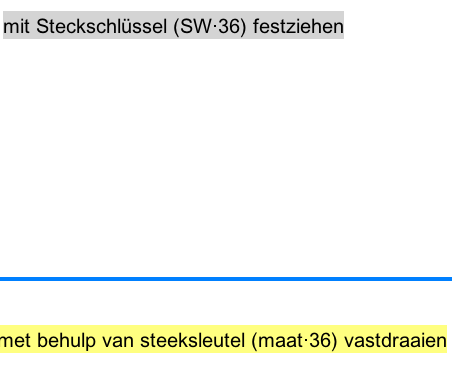Depending on your language combination and direction, verbs that are separable in your target language but not in your source language can cause problems for (normal) auto-assembling. In these cases regular expressions can improve the result of auto-assembling.
Auto-assembling can be hindered by blockers like item numbers. The symbolic representation is:
Source: XXX YYY (1).
Target: XXX' (1) YYY'.
Example 1:
Your glossary for German > Dutch contains the entry:
Lösen Sie die Schraube=Draai de schroef los
CafeTran will create a well-formed auto-assembled translation:
German: Lösen Sie die Schraube.
Dutch: Draai de schroef los.
Now your source segment contains an auto-assembling blocker:
German: Lösen Sie die Schraube (1).
The result of auto-assembling will be an incorrect translation:
Dutch: Draai de schroef los (1).
Here, regular expressions can improve auto-assembling results and create the correct translation:
Dutch: Draai de schroef (1) los.
Example 2:
English: Tighten screw #1.
German: Ziehen Sie die Schraube (1) an.
Example 3:
English: Unscrew/Loosen screw #1.
Dutch: Draai schroef (1) los.
Setting up the glossary
Imagine that you have to translate a manual that contains instructions like:

The inseparable German 'Lösen Sie X' is translated into Dutch by the separable 'Draai X' los' (where X/X' represents an object).
Create a glossary that contains the following regular expressions:

(The triangles Δ represent tab characters, the bullets ● non-breaking spaces.)
In the tabbed pane you will see the following representation of the regular expressions above:

Auto-assembling will automatically place the separable part of the verb ('los', from Dutch 'losdraaien') at the correct position (behind the blocker):

TIP: You can cover spelling errors and uppercase/lowercase variants by means of a regular expression too:

Note that CafeTran will take care of the handling of the case of the first letter at the start of the target segment automatically (uppercase or lowercase where required).
Exercise: Search your glossary for entries with digits, and replace these digits with regular expressions in order to make the glossary entries even more useful.
Read more about Separable Verbs
Some more examples
Wolfgang sends some nice examples for English > French:
- Only glass bottles (1) - Bouteilles en verre (1) uniquement.
- Don't start the motor (1) - Le moteur (1) ne doit pas être démarré.
- Remember to close that door (1) - Ne pas oublier que cette porte (1) doit rester fermée.
Example with multiple numbers
When multiple numbers are combined in one set of brackets:

Related example
This is not about splittable verbs but the example is so nice that I want to show it here:

Normally, CafeTran would make the word "maat" uppercase. By including it in a spanning glossary entry, with regular expressions, you can prevent this. Awesome!
Using a special glossary for regular expressions
You can define regular expressions at the glossary level. Just add the following line to your .res files:
Regular expressions only=yes or no
Then, you can skip adding the pipe in front of terms when this flag is on.